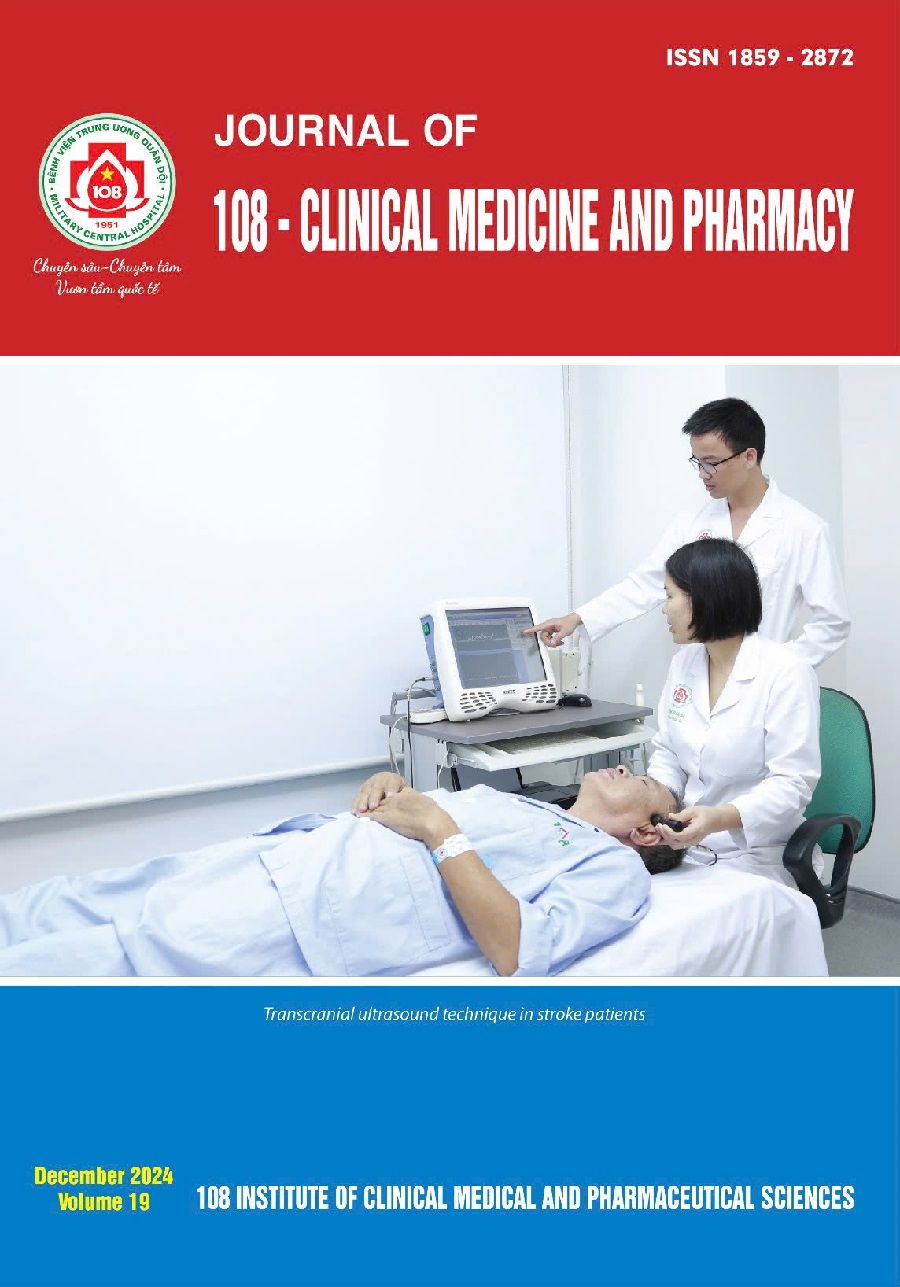Studying on single nucleotide polymorphisms of A20 gene in non-Hodgkin lymphoma patients
Main Article Content
Keywords
Tóm tắt
Objective: To identify single nucleotide polymorphisms (SNPs) in exon 7 of A20 gene in non-Hodgkin lymphoma (NHL) patients and evaluate the association between these SNPs and some prognostic indicators in NHL patients. Subject and method: 83 patients were diagnosed with NHL and 83 healthy controls. Sanger sequencing technique was used to analyze SNPs in exon 7 of A20. Result: Seven SNPs were identified in the patient sample including A20: c.1308 A>C (p.K337Q), c.1341 C>T (p.L348F), c.1356 T>C (p.Y353H), rs2114496684 C>T, rs1776324713 A>T, c.1378 G>C (p.S360T) and rs2114496220 T>A. In which, two genotypes CT and GC of SNP rs2114496684C>T and c.1378G>C respectively had higher frequencies in the NHL group compared to the control group with a statistically significant (p<0.05). Four SNPs: c.1308A>C (p.K337Q), c.1341C>T (p. L348F), c.1356T>C (p.Y353H) and rs2114496684C>T (p.Q357*) were predicted to be associated with a high risk of NHL using Mutation Taster, CADD and Polyphen_2 bioinformatics software. There was no statistically significant difference in the genotype distribution of these SNPs with some prognostic indicators such as stage, progression, LDH and beta2-microglobulin index in NHL patients. Conclusion: Seven SNPs were identified in exon 7 of A20 in the NHL patient group, of which two SNPs with heterozygous genotypes appeared with a higher frequency in the patient group compared to the control group with statistical significance, and four SNPs were predicted to be associated with hight risk of NHL. There was no statistically significant association between the genotype distribution of these SNPs and some prognostic indicators in NHL patients.
Article Details
Các tài liệu tham khảo
2. Sung H, Ferlay J, Siegel RL et al (2021) Global cancer statistics 2020: GLOBOCAN estimates of Incidence and mortality worldwide for 36 cancers in 185 Countries. CA: A cancer journal for clinicians 71(3): 209-249.
3. Honma K, Tsuzuki S, Nakagawa M et al (2009) TNFAIP3/A20 functions as a novel tumor suppressor gene in several subtypes of non-Hodgkin lymphomas. Blood, The Journal of the American Society of Hematology 114(12): 2467-2475.
4. Trang DT, Giang NH, Trang BK et al (2022) Prevalence of CYLD mutations in Vietnamese patients with polycythemia vera. Advances in Clinical and Experimental Medicine 31(4): 369-380.
5. Nguyen Thanh Huyen (2023) Study on the regulatory role of A20 and CYLD genes on cell function in myeloid leukemia patients. Doctoral thesis. University of science and technology. Vietnam Academy of Science and Technology. 2023.
6. Chang YC, Chang YS, Chang CC et al (2016) Development of a high-resolution melting method for the screening of TNFAIP3 gene mutations. Oncology Reports 35(5): 2936-2942.
7. Chen C, Zhou L, Zhu L et al (2023) TNFAIP3 mutation is an independent poor overall survival factor for patients with T-cell acute lymphoblastic leukemia. Cancer Medicine 12(4): 3952-3961.
8. Shaheen ZR, Williams SJA and Binstadt BA (2021) Case Report: A Novel TNFAIP3 mutation causing haploinsufficiency of A20 with a Lupus-like phenotype. Front Immunol 12: 629457.
9. Zhu L, Zhang F, Shen Q et al (2014) Characteristics of A20 gene polymorphisms in T-cell acute lymphocytic leukemia. Hematology 19(8): 448-454.
10. Cen H, Tan X and Guo B (2015) A20 mutation is not a prognostic marker for activated B-cell-like diffuse large B-cell lymphoma. PLoS One 10(12): 145037.
11. Shaat RM, Ghaffar HA, Shamaa S et al (2023) Clinicopathological significance of A20 genetic mutation in Diffuse large B-Cell lymphoma. The Egyptian Journal of Hospital Medicine 90(1): 1680-1683.
12. Elbaz O, Shaat RM, Ghaffar HA et al (2023) The prevalence of MYD88 L265P and TNFAIP3 mutations and their correlations with clinico-hematological profile in Egyptian patients with Diffuse large B cell lymphoma. Asian Pacific Journal of Cancer Prevention 24(7): 2485-2491.
 ISSN: 1859 - 2872
ISSN: 1859 - 2872
